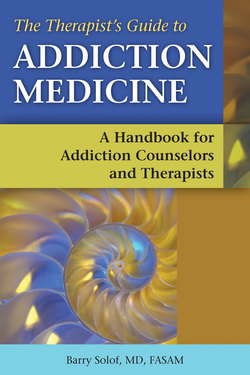Читать книгу The Therapist's Guide to Addiction Medicine - Barry Solof - Страница 10
На сайте Литреса книга снята с продажи.
ОглавлениеINTRODUCTION
Merriam-Webster defines addiction as “a compulsive need for and use of a habit-forming substance (as heroin, nicotine, or alcohol) characterized by tolerance and by well-defined physiological symptoms upon withdrawal” or in a broader definition, “the persistent compulsive use of a substance known by the user to be harmful.”1
Historically, addiction has been defined as physical and psychological dependence on psychoactive substances (for example alcohol, tobacco, heroin, caffeine, and other drugs) that cross the blood-brain barrier, and once ingested, temporarily alter the chemical milieu of the brain. Addiction can also be viewed as a continued involvement with a substance or activity despite the negative consequences associated with it.
Addiction begins as a pursuit of pleasure, enjoyment, or relief from actual or perceived ailments; however, over a period of time more involvement with the substance or activity (such as gambling, eating, or sex) is needed to feel normal. In other words, a person starts doing it to feel good and then has to continue doing it to keep from feeling bad.
However we define it, humankind has been experimenting with mind-altering substances ever since we first discovered that grapes would ferment into wine. Since then, we’ve used our intellect, imagination, and ability to create myriad new ways to alter our consciousness through the use of addictive drugs and behaviors. Unfortunately, some people go on to develop serious problems when they go down this road. It has often been said that in the beginning of this deterioration, the use of drugs sometimes “gets in the way of the person’s life.” Later on, “life gets in the way of the person’s drug use.”
This is not a book about counseling or therapy. We already have more than enough books that deal with that subject area. This is a book about the essential biological and medical knowledge that a therapist or counselor should have if he or she desires to work effectively with addicts (including alcoholics). Throughout my many years as a physician working in this field it has been disappointing to observe that so many well-meaning therapists and counselors seem to know relatively little about the biological and medical aspects of addiction. The consequences of this lack of knowledge lead to suboptimal care and treatment for this very vulnerable patient population.
I hope that in some small way this book will lead to improved integration of the medical and counseling fields. The Therapist’s Guide to Addiction Medicine has been written as a basic guide to assist counselors and therapists in helping their clients recover from the disease of addiction. Although The Therapist’s Guide to Addiction Medicine was envisioned as a handbook for addiction counselors and therapists, I have tried to make it easy to understand so that it can be used as an educational and self-awareness resource for anyone who struggles with addiction or is living with or caring for someone who suffers from this disease.
INTRODUCTION NOTES
1 By permission. From Merriam-Webster’s Collegiate® Dictionary, 11th Edition, ©2013 Merriam-Webster. Inc. (www.Merriam-Webster.com).
